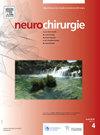清醒手术直接电刺激安全切除深后丘脑海绵体畸形。
IF 1.4
4区 医学
Q4 CLINICAL NEUROLOGY
引用次数: 0
摘要
背景:由于手术风险,治疗症状性深部脑海绵体畸形(CCMs)具有挑战性。病例描述:一名37岁男性接受清醒开颅直接电刺激(DES)切除左侧后丘脑CCM。经皮质经脑室入路经顶叶上,可安全绕过关键联合和投射白质束。结果:术后MRI证实完全切除并保留了大束,患者在3个月时恢复明显。结论:本病例强调了DES清醒手术作为一种安全有效的方法治疗传统上被认为无法手术的深层ccm的潜力。本文章由计算机程序翻译,如有差异,请以英文原文为准。
Awake surgery with direct electrical stimulation for safe resection of a deep posterior thalamic cavernous malformation
Background
Treating symptomatic deep-seated cerebral cavernous malformations (CCMs) is challenging due to surgical risks.
Case description
A 37-year-old man underwent awake craniotomy with direct electrical stimulation (DES) for excision of a left posterior thalamic CCM. A transcortical transventricular approach through the superior parietal lobe enabled safe navigation around critical associative and projection white matter tracts.
Results
Postoperative MRI confirmed complete resection with preservation of major tracts, and the patient showed significant recovery at three months.
Conclusion
This case highlights the potential of awake surgery with DES as a safe and effective method for deep-seated CCMs traditionally deemed inoperable.
求助全文
通过发布文献求助,成功后即可免费获取论文全文。
去求助
来源期刊

Neurochirurgie
医学-临床神经学
CiteScore
2.70
自引率
6.20%
发文量
100
审稿时长
29 days
期刊介绍:
Neurochirurgie publishes articles on treatment, teaching and research, neurosurgery training and the professional aspects of our discipline, and also the history and progress of neurosurgery. It focuses on pathologies of the head, spine and central and peripheral nervous systems and their vascularization. All aspects of the specialty are dealt with: trauma, tumor, degenerative disease, infection, vascular pathology, and radiosurgery, and pediatrics. Transversal studies are also welcome: neuroanatomy, neurophysiology, neurology, neuropediatrics, psychiatry, neuropsychology, physical medicine and neurologic rehabilitation, neuro-anesthesia, neurologic intensive care, neuroradiology, functional exploration, neuropathology, neuro-ophthalmology, otoneurology, maxillofacial surgery, neuro-endocrinology and spine surgery. Technical and methodological aspects are also taken onboard: diagnostic and therapeutic techniques, methods for assessing results, epidemiology, surgical, interventional and radiological techniques, simulations and pathophysiological hypotheses, and educational tools. The editorial board may refuse submissions that fail to meet the journal''s aims and scope; such studies will not be peer-reviewed, and the editor in chief will promptly inform the corresponding author, so as not to delay submission to a more suitable journal.
With a view to attracting an international audience of both readers and writers, Neurochirurgie especially welcomes articles in English, and gives priority to original studies. Other kinds of article - reviews, case reports, technical notes and meta-analyses - are equally published.
Every year, a special edition is dedicated to the topic selected by the French Society of Neurosurgery for its annual report.
 求助内容:
求助内容: 应助结果提醒方式:
应助结果提醒方式:


